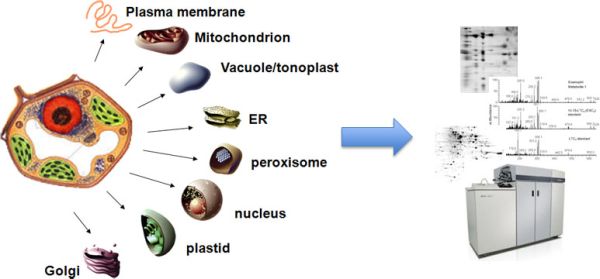
Nuclear-encoded proteins distribution and compartments development inside cells enables specific cellular functions. The exploration of the proteome of the cell in terms of the collection of its subcompartments is therefore both a practical approach and a necessary function assay. It demonstrates that proper interpretation of proteomic data requires information about compartmentation of protein machinery.
Subcellular proteomics decreases the complexity of proteomie discovery. With the typical compartment representing 500-4000 proteins, gel and MS based technique assist to reach a high-level of analytical resolution. In contrast, whole cell proteomes of 12, 000-40, 000 proteins extend well beyond the ability of proteomic tools to resolve them, leaving the studies being “tip of the iceberg” activities. Subcellular proteomics stands on the shoulders of decades of biochemical research that has developed methods for isolation of subcellular compartments. Extensive laboratory work involving the tinkering with density, size, and charge separation techniques has enabled incremental limitation of contamination in isolation methods from a range of subcellular structures.
Based on the powerful combination of subcellular fractionation and protein identification by LC-MS/MS, it enables us to develop the subcellular proteomics approach for the characterization of subcellular compartments.
Recent success stories demonstrated that the combination of subcellular prefractionation methods with proteomic analysis seems to be an potent approach to simplify complex protein extracts from cells or tissues and then facilitate low abundance proteins detection. It revealed that sophisticated strategies encompassing sample preparation, analytics and validation steps were required to fully exploit the potential of subcellular proteomics.
Our Subcellular Proteomics Service
Creative Proteomics uses Thermo Fisher's Orbitrap Fusion Lumos mass spectrometry platform combined with nanoLC-MS/MS nanoliter chromatography to provide subcellular proteomics analysis services. Combining years of experience in proteomics research, we have successfully achieved qualitative and quantitative analysis of multiple subcellular organelle components, including membrane proteome, chloroplast proteome, mitochondrial proteome, etc.
Biological membranes are the basic structures of cells and assume important functions in almost all life activities, which are mainly realized through membrane proteins. Abnormal functions of membrane proteins are directly related to many diseases, 50% of which are the targets of currently known drugs. Membrane proteomics can be used to find disease markers, screen drug targets, etc.
Chloroplasts are the main site of photosynthesis in plants and are one of the organelles containing genetic material in addition to the nucleus. Chloroplast proteomics is important for elucidating the laws of chloroplasts in plant growth and development and metabolic regulation and other life activities.
Mitochondria are the regulatory centers of cellular energy metabolism, biosynthesis and cell death, and changes in their protein structure and function can lead to the development of many diseases. Mitochondrial proteomics studies can provide an important theoretical basis for analyzing the physiological functions of mitochondria, exploring the pathogenesis of mitochondria-related diseases and promoting mitochondria-targeted drug development.
Exosomes are microsecretory vesicles, which are one of the products of intracellular vesicular transport and play an important role in physiopathological processes such as antigen presentation, tumor growth and migration, and repair of tissue damage. The exosome proteomics may facilitate further studies of exosome-related mechanisms and clinical applications.
Subcellular Proteomics Service Workflow

Technical Advantages
Highly stable protein extraction method: Optimized extraction protocol to increase extraction purity by 10-20% and protein throughput by 15%
High-performance mass spectrometry system: Equipped with a high-performance mass spectrometry system and full-scan acquisition method of of SWATH, which effectively enhances the identification of subcellular proteins with very low abundance
Multi-database integration: By integrating multiple relevant high-quality protein databases, the accuracy and throughput of subcellular protein localization is greatly improved
Multi-dimensional data analysis: In addition to comparing the identified proteins with more relevant subcellular databases, multiple software programs are used for predictive analysis of subcellular localization based on computational methods to further increase the identification throughput.
Creative Proteomics also provide the following bioinformatics services in Subcellular Proteomics:
- Functional annotation and enrichment analysis
- Clustering analysis
- Network analysis
- Statistical analysis
Please feel free to Contact Us to discuss your projects. We hope you will find that we can meet your research needs.















